
Grace Ndiritu: Compassionate Rebels in Action. The Ignorant Art School Sit-in #5. Photo: Sally Jubb, courtesy Cooper Gallery, DJCAD.
Cooper Gallery, Duncan of Jordanstone College of Art and Design, Dundee
10 October – 13 December 2025
by VERONICA SIMPSON
With a sense of some excitement and anticipation I wander into the Cooper Gallery, part of Duncan of Jordanstone College of Art and Design in Dundee, to encounter the work of the British Kenyan (Maasai Kikuyu) artist and film-maker Grace Ndiritu (b1982). My interest was sparked by having seen Ndiritu’s film Black Beauty (2021), for which she won the 2022 Film London Jarman Award, and a quirky and thought-provoking installation of historic and contemporary artefacts, as part of Nottingham Contemporary’s 2022 show Our Silver City 2094. I also appreciated the quiet, contemplative provocation of her 2022 Healing Pavilion at the Wellcome Collection. Part of her continuing project to “heal the museum” – detoxify centuries of patronising colonial and extractive practices – it comprised a room styled as a temple, where you could meditate on the provenance and perspectives of 20th-century collectors and curators of “ethnic” artefacts, as exemplified by two striking archival photographs reproduced as tapestries.
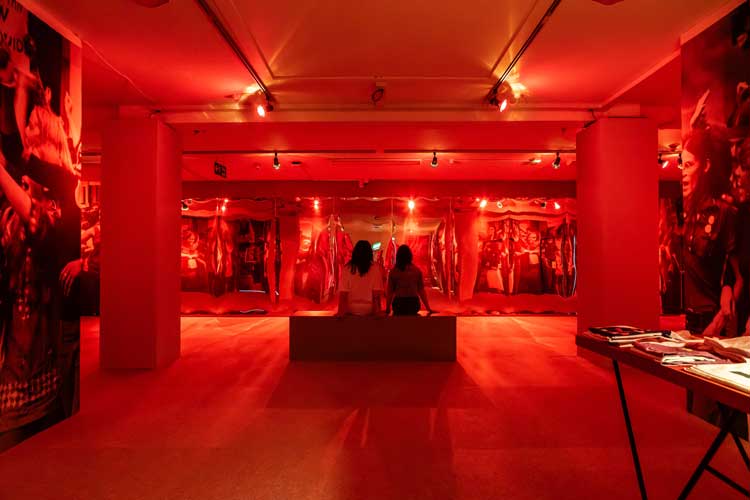
Grace Ndiritu: Compassionate Rebels in Action. The Ignorant Art School Sit-in #5. Photo: Sally Jubb, courtesy Cooper Gallery, DJCAD.
There, as here in Dundee, visitors were politely requested to remove their footwear, temple-style, at the entrance. But here, the place feels more like a nightclub than a temple – albeit a feisty, young feminist nightclub. The lights are tinted red, the wall coverings alternate between reflective panels and images of young women at a protest. Are the mirrored panels intended to make me feel part of their community? Does seeing my reflection bound in with their exuberant, youthful outrage make me feel part of their crowd? Not really. Images of the same small group of women are repeated around the room, so the fiction of being at a gathering of protesters falls apart somewhat. (It turns out that the images were taken in New York City during the Women’s Strike for Equality on 26 August 1970, a seminal moment in 70s feminism, but does the significance of the event turn a mediocre documentary photograph into an artefact, simply because it is placed on a wall?). I follow the “exhibition continues” signs upstairs to the main galleries, hoping for something that qualifies as an artwork to remind me that I am at an art exhibition. But there is only grainy, home-movie style footage, projected on the wall, of two activist communities of which Ndiritu was once part, plus a conscious activist community she later devised, under the name The Ark (of which, more later).
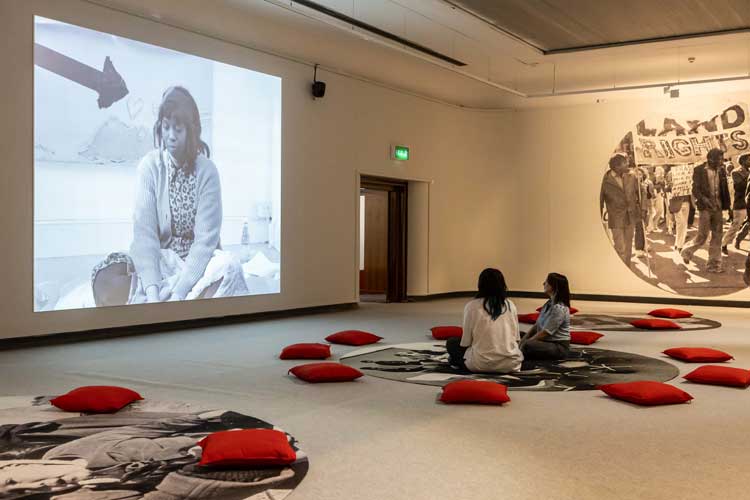
Grace Ndiritu: Compassionate Rebels in Action. The Ignorant Art School Sit-in #5. Photo: Sally Jubb, courtesy Cooper Gallery, DJCAD.
I enter a room full of black beanbags and red cushions, with more black-and-white images of activists, seemingly directly printed or woven on to rugs or tapestries. Again, these are from the archives of significant protest movements or art activists. One of those featured is Li Yuan-chia, who set up the LYC Museum and Art Gallery in Cumbria in the 1970s, showcasing artists such as Andy Goldsworthy and David Nash, who were then considered outside the system. It is like wandering into an activist’s family album.

Grace Ndiritu: Compassionate Rebels in Action. The Ignorant Art School Sit-in #5. Photo: Sally Jubb, courtesy Cooper Gallery, DJCAD.
The rugs are listed in the programme as artworks – such as Protest Carpet: LYC – Man Digging (2023) is an image of Yuan-chia in his garden in Cumbria. The leaflet tells us it was “commissioned and activated at Kettle’s Yard” (which would have been for the 2023 show Making New Worlds: Li Yuan-chia and Friends). This is all very interesting, but I am struggling to see how taking an unremarkable documentary photograph and rendering an exact reproduction of it in another material makes it “art”. I find myself questioning the use of the word “activated” in the description of each of the Protest Carpets. If they were used in a particular event hosted by Ndiritu, does that give them extra significance? Not to those of us who weren’t at the event. Art is surely the translation of what might otherwise be ordinary images and materials into something more arresting, more universal, more lasting, through that act of artistry and skill, as indeed Ndiritu did with her Nottingham Contemporary presentation, and her Wellcome Collection installation. The value of these carpets seems primarily as archive imagery used to amplify a thematic context.
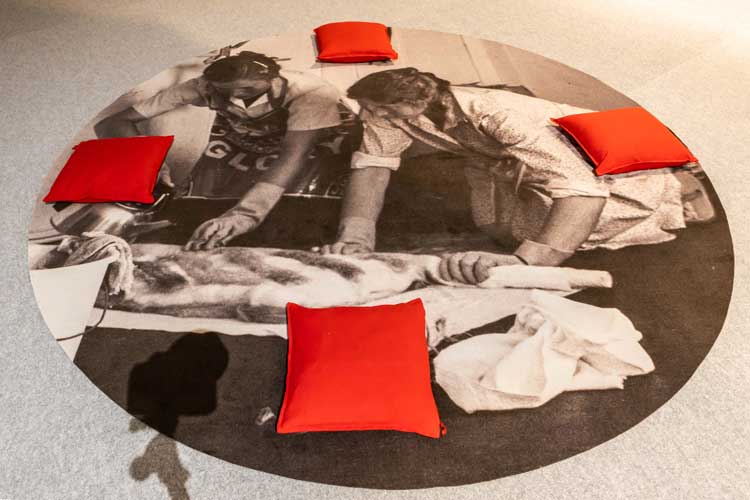
Grace Ndiritu: Compassionate Rebels in Action. The Ignorant Art School Sit-in #5. Photo: Sally Jubb, courtesy Cooper Gallery, DJCAD.
But that’s when I am reminded that this is no ordinary art show. It is the final episode in an ambitious series of five exhibitions reflecting on art practice, art education, anarchy and the collective imagination – encouraging reflection on what any of this means in these fragmented, volatile times. Sit-in #5, Ndiritu’s chapter, is subtitled Compassionate Rebels in Action. It draws on her years spent in activist, off-grid, Buddhist or Indigenous spiritual communities, as well as her more recent work encouraging museums and their staff to question the institutional and academic set-up, from collection procurement and provenance to presentation.
Is my concern at the absence of actual “art” an indication of how “colonised” my approach has been by traditional institutional tropes? To be fair, there are two films on a screen in Gallery 2 – one of which is a performance. The other is Ndiritu leading a group of participants through a discussion around John Latham’s Flat Time House at its location in south London as part of the 2022 exhibition Untitled, 1956, which is not a performance but a reading group. The performance is Labour: Birth of a New Museum (2023), showing Ndiritu taking a group of pregnant women on a “shamanic journey” to discover the “soul” name of their unborn child. But when does a guided meditation become a shamanic ritual? At this point, I feel uneasy – it seems Ndiritu herself is presented as the object of significance, not the work. Is a cult of personality being created? And who is doing the creation?
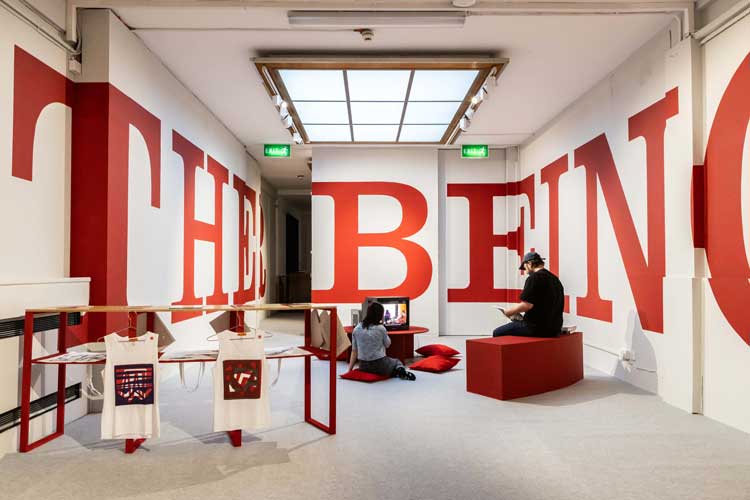
Grace Ndiritu: Compassionate Rebels in Action. The Ignorant Art School Sit-in #5. Photo: Sally Jubb, courtesy Cooper Gallery, DJCAD.
In a third gallery, called the Study Room, various items of relevant literature are presented on Latham and his educational approach, and a TV is showing multiple recordings of interviews of Ndiritu by assorted curators and writers. There is also a glossary of terms Ndiritu has collated – none of them remarkable, and only one or two of which she might be said to have “coined” – which Cooper Gallery has published in a glowing red book, Glossary for Art and Action, to aid people on their own journey of emancipation. This is referred to by the director and principal curator of the gallery, Sophia Yadong Hao, on more than one occasion – playfully, I hope – as Grace’s “Little Red Book”, which reinforces the feeling that this show is all about the artist, with very little art.
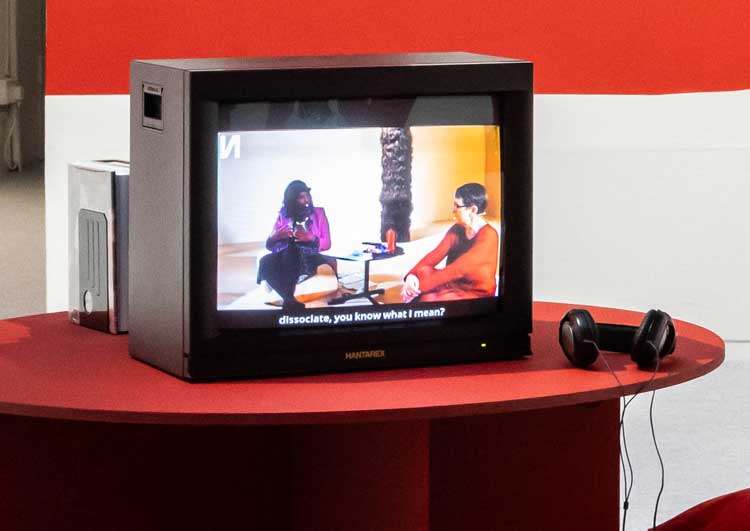
Grace Ndiritu: Compassionate Rebels in Action. The Ignorant Art School Sit-in #5. Photo: Sally Jubb, courtesy Cooper Gallery, DJCAD.
None of the above, however, is intended to detract from the ambition of the series of investigations and explorations, of which this is the concluding part, conceived by Hao. The title The Ignorant Art School was inspired by French philosopher Jacques Rancière’s 1987 book The Ignorant Schoolmaster: Five Lessons in Intellectual Emancipation. Hao tells me: “In the book, Rancière tells a story of a French teacher, Joseph Jacotot, who was sent to the Netherlands in 1818, and ended up teaching French without knowing any Flemish. He learned Flemish while the students learned French [using a dual translation of a French novel, François Fénelon’s Télémaque].” Jacotot’s non-hierarchical approach became famous, disseminated around parts of Europe as an educational system that saw pupil and teacher as equals, learning through an “emancipatory” method of self-directed and collective enquiry.
Hao says: “I loved the title, though The Ignorant Art School is a little bit tongue in cheek. The ‘sit-ins’ (attached to each episode) were inspired by Hornsey art school, and their protest in the 1960s against the institutionalisation of creative education. I’m trying to match these events together. The whole project … really focuses on alternative art pedagogy, experimentations that happen within an institution.”
Hornsey College of Art featured in 2021’s Sit-In #2, To Be Potential, in which the gallery was laid out in a classic schoolroom style (desks, chairs, blackboards) and showcased a wide range of alternative art institutions and educational experiments, from the Bauhaus to the Free University of New York. Greg Thomas, reviewing this and the preceding episode for Art Monthly, remarked on how many “sites of egalitarian creation” came from the global south, including the 1990s Womanifesto gatherings in Thailand and Indonesia’s Gudskul collective project. He felt the show succeeded in immersing visitors in the spirit and atmosphere of a period when, as he said: “Arts education (was seen as) collective intellectual emancipation, the fostering of new bases for cultural and societal organisation.” Sadly, from the UK art school perspective that movement is fading, bludgeoned into submission by the new “factory” model of further education, and its relentless monetisation. Could Hao’s initiative spark a revival? Certainly, it could stimulate activity at grassroots level. As Thomas concludes: Hao is “unapologetically ideas-led … This is not a series staked on blockbuster visuals or sensory delights.”
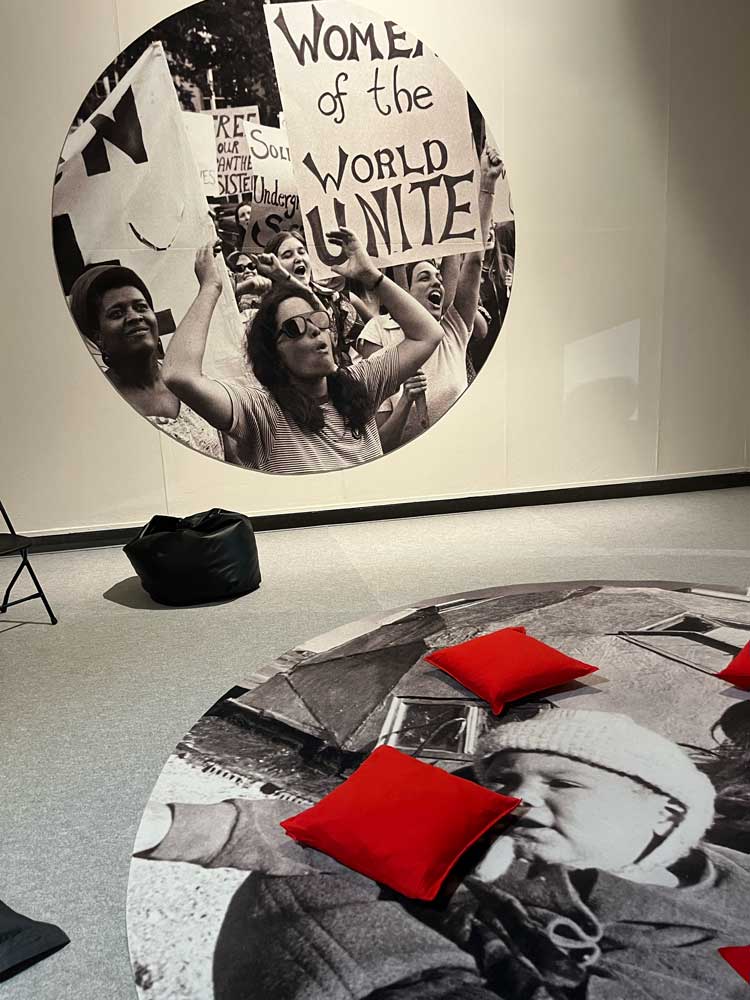
Grace Ndiritu: Compassionate Rebels in Action. The Ignorant Art School Sit-in #5, Cooper Gallery, DJCAD. Photo: Veronica Simpson.
Call me shallow, but I wouldn’t have minded some visual delights. They were surely present in the first Ignorant Art School in 2021. Ruth Ewan’s show, We Could Have Been Anything That We Wanted to Be and It’s Not Too Late to Change, was a site-specific investigation into local radical traditions, celebrating the once-mighty industrial city of Dundee’s socialist heritage, from strong feminist activism back to its links to the French Revolution. Conducted largely online during lockdown periods, with events recalling “An A-Z of Dundonian Dissent”, the artist also planted an indoor wildflower meadow in the gallery – How Many Flowers Make the Spring? (2021), featuring native and invasive plants – around which she placed speakers broadcasting testimonials from Dundonians, on what inspired or moved them to become activists (ranging from anti-Vietnam marches to the Battle of Kenmure Street in 2021, when Glaswegians resisted a Home Office attempt to detain two Sikhs from the community “for suspected immigration offences”).
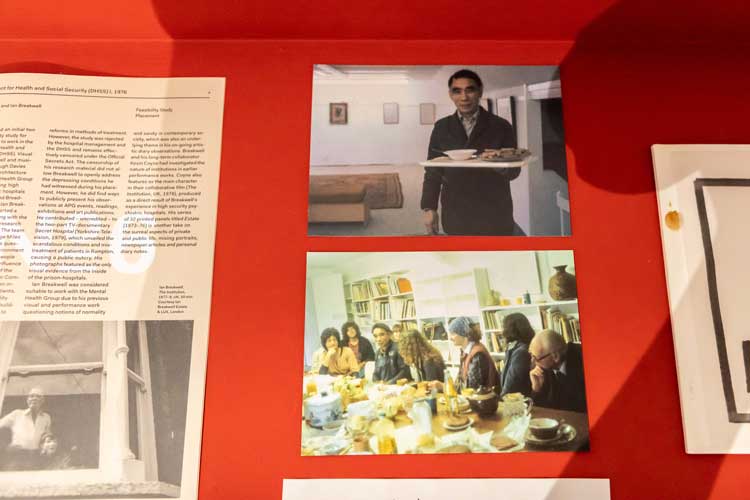
Grace Ndiritu: Compassionate Rebels in Action. The Ignorant Art School Sit-in #5. Photo: Sally Jubb, courtesy Cooper Gallery, DJCAD.
Ndiritu’s Sit-in #5 is intended to “centre practices of radical spirituality, pedagogy, social justice and decolonisation as compassionate and holistic means to achieve new ways of ‘being together’,” according to the publicity material. But a set of films, some books, some photographic archive and a few beanbags alone won’t achieve that. Which is why the show – elaborated in the same leaflet – foregrounds a series of events, programmed with Ndiritu, and inspired by her book Being Together: A Manual for Living. I attended the first, titled Living Together, at which Ndiritu was present. She was interviewed by Hao, and the session was bookended with two short meditations (far too short to have brought anyone into more than the mildest state of relaxation, which makes one question their purpose). Hao asked her about The Ark initiative, held in 2017 at Les Laboratoires d’Aubervilliers, France. Billed as a “Centre for Interdisciplinary Experimentation”, it sounds as if The Ark was part meditation and creativity retreat, part discussion group, conducted within a closed community for 10 days. Nothing like that is planned for Dundee – though two of the previous sit-in exhibitions have incorporated additional, 12-hour sit-in experiences. Another event in this series, Feeling Together, was scheduled the week after the opening: a conversation between Ndiritu and her Buddhist teacher, Lama Rinchen Palmo (let’s hope the meditation lessons go a little deeper). Other events planned include a fashion workshop, titled Coverslut, after Ndiritu’s “fashion and economic research” project, comprising items made with young artists and migrants, sold on a “pay what you can” basis. Later, there will be a reading group facilitated by writer and film-maker Gareth Evans, focusing on John Berger’s 1968 article The Nature of Mass Demonstrations; there are also two Writing and Decolonising workshops, bringing in the School of English at the University of St Andrews, and a Growing and Eating Together session, facilitated by artist/gardener Jek McAllister. All these will be enjoyable and enriching, no doubt, especially to the Duncan of Jordanstone College students who have followed all or part of the Ignorant Art School’s journey so far. But others in the community have dived in too: after Ndiritu and Hao’s talk, a man in the audience introduced himself as president of Dundee University Student Association. He praised the ambition and generosity of the series, having attended all the editions. Then he asked the assembled audience – the majority of whom were students or young artists – “How will you take the spirit of this re-education forward?” A very good question, which I put to Hao.
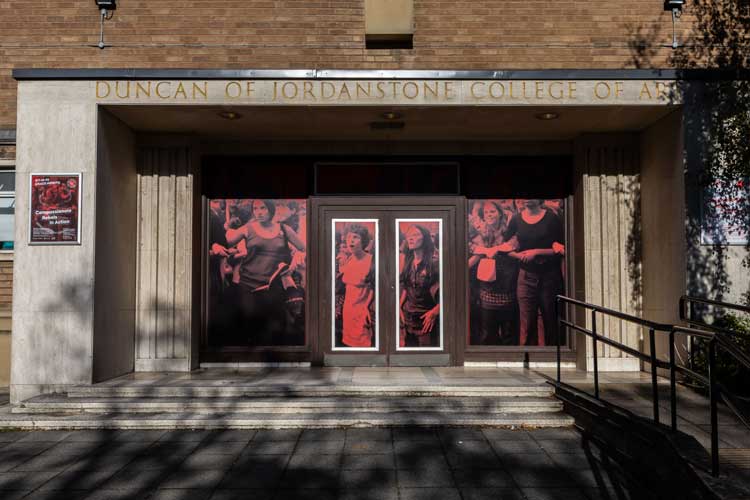
Grace Ndiritu: Compassionate Rebels in Action. The Ignorant Art School Sit-in #5. Photo: Sally Jubb, courtesy Cooper Gallery, DJCAD.
She said: “A lot of people think the Ignorant Art School is about art education. Yes, it is, but it’s more about taking on inspiration from alternative practices, and having a critical position within the institution. But I think more and more as the project develops, we really emphasised questioning the definition of knowledge, where it’s formed and who has the power to define what is knowledge and how it is shared … Throughout the project, the main inspiration is bell hooks … [and her] idea of unlearning.”1
Asked about the core audience, Hao agrees that many have come from the adjacent art school. But she says: “When we started, I was almost thinking this could be like a night school for people already out of education – this free access to new ideas, or just a gathering space. And for people to feel confident again to reclaim knowledge.”
Through the series, Hao’s events programme is about opening up possibilities for knowledge expansion and enrichment, and she has brought a fascinating and impressive participating community of activists and educationalists, including pioneering feminist art historian Griselda Pollock from the University of Leeds. For the first of the two 12-hour sit-ins, she invited Ruangrupa, one of the three collectives that established Indonesia’s Gudskul knowledge-sharing platform in 2018. She says: “They set up what they called a Knowledge Market: people were choreographed to sit on these two sets of chairs, and people sit face to face, and they just share what they consider to be their knowledge. They really boost each other’s confidence, and make people question what knowledge is, the hierarchies within the knowledge system. And at the end everyone gets a certificate.”
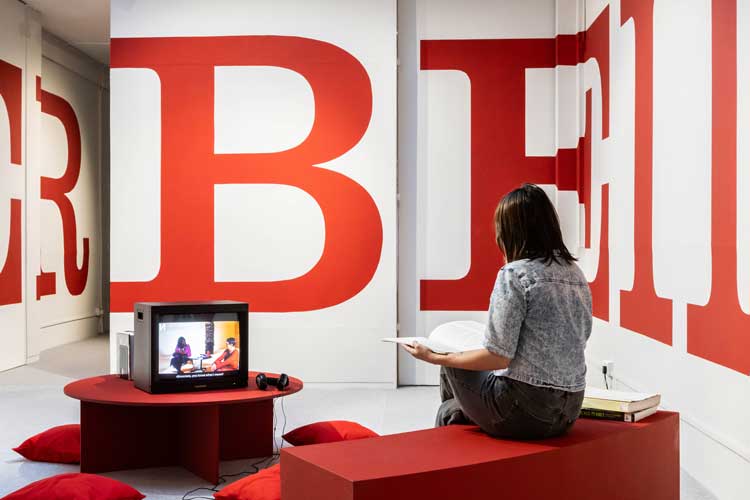
Grace Ndiritu: Compassionate Rebels in Action. The Ignorant Art School Sit-in #5. Photo: Sally Jubb, courtesy Cooper Gallery, DJCAD.
I mention to Hao my misgivings about the lack of actual art. She says: “Cooper Gallery’s programming characteristics really focus on events … For Cooper Gallery, the preview would be only the starting point for a whole series of events. The Ignorant Art School is the best example of how, for me, curating is a discourse-building exercise. We are curating the discourse. There are ongoing conversations, and facilitating the ongoing conversation is the absolute aim of the project. Through the events we invite facilitators, artists, writers, performers and they get to know each other’s work as well.” This is about building community, she says. And over the course of three years, it has certainly built community – both for participant students and visitors but also participating artists. She says: “Artists started inviting each other to do other things with them. Definitely new communities have been formed, and they have gone on to do their own things.”
As for Ndiritu’s edition, she says: “We’re hoping this whole event series designed with Grace will attract people from all walks of life, sharing our aspirations of building bridges and finding a way to be together. Just the current political and social situation is really hard on everyone. Grace is focused on spirituality, on compassion. She’s trying to tell people you’re part of the artwork, and there’s no boundary between the artwork and the audience.”
While hugely impressed with the research and spirit and dedication that has gone into this whole exercise, and wishing the project well in the new communities and connections it has fostered, I suspect meditations, bean bags and discussion groups won’t be sufficient to propel the next generation of artist activists to greatness, without a rigorous spirit of critical evaluation and aesthetic ambition. If anything, it brings to mind the contrast between two recent feminist shows. The Barbican’s 2023 Re/Sisters was exhilarating in demonstrating not just the breadth and range of a great number of feminist and ecological activist groups over the decades, but also their creativity, ingenuity and brilliance in driving their message home. On the other hand, the Tate’s 2023 Women in Revolt! was far too heavily weighted towards archive documentation, with far too little art to sustain the spirit and put fire in the belly.
Reference
1. Teaching to Transgress: Education as the Practice of Freedom, by bell hooks, 1994.